#her niblos
Explore tagged Tumblr posts
Text

Kuromi with her friggin nipis out
#im honestly kinda speechless like why r her bibis out#her niblos#her babas#put those away girl omg#ganja's diary
10 notes
·
View notes
Text
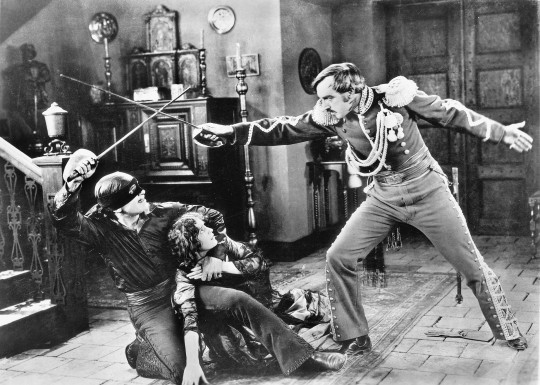
Douglas Fairbanks, Marguerite De La Motte, and Robert McKim in The Mark of Zorro (Fred Niblo, 1920)
Cast: Douglas Fairbanks, Noah Beery, Charles Hill Mailes, Claire McDowell, Marguerite De La Motte, Robert McKim, George Periolat, Walt Whitman, Sidney De Gray, Tote De Crow. Screenplay: Douglas Fairbanks, Eugene Miller, based on a magazine story by Johnston McCulley. Cinematography: William C. McGann, Harris Thorpe. Art direction: Edward M. Langley.
Film firsts are usually worth checking out, and The Mark of Zorro is a double first: It's the first appearance of the title character on screen, and it's the first of the genre of films for which Douglas Fairbanks remains best-known, the swashbuckler. Since Fairbanks and co-scenarist Eugene Miller adapted Johnston McCulley's 1919 magazine story, "The Curse of Capistrano," the masked hero has been played by Tyrone Power, Guy Williams (in the Disney TV series), Frank Langella, George Hamilton (in a spoof featuring Zorro's gay twin brother), Alain Delon, and (as the aging Zorro and his hand-picked successor) Anthony Hopkins and Antonio Banderas, and appeared in numerous Mexican and European films. The trope of the do-gooder who pretends to be a wimp but turns into a force for justice has its precursor in the Baroness Orczy's play and novel The Scarlet Pimpernel and lives on in countless superhero tales, most notably the Clark Kent/Superman story. As the languid fop Don Diego Vega, Fairbanks affects a weary slouch and spends his time doing tricks that involve a handkerchief. When he turns into Zorro, with mask and scarf over his head, he pastes on a little mustache oddly reminiscent of Boris Badenov, and succeeds in taking on the villains with great élan. The film itself begins slowly, with too much exposition crammed into the intertitles, but eventually Fairbanks gets his act together, and the climax of the movie is a hilarious showpiece for his acrobatic moves. He leads the Capistrano constabulary on a merry chase over walls and across rooftops, inevitably tempting them into disaster: He leaps over a pigsty, for example, whereupon the pursuers fall into it. At the end, revealing his secret identity, he wins the hand of Lolita Pulido (Marguerite De La Motte), by saving her family's estate from the clutches of the evil governor (George Periolat) and his henchmen, Capitán Juan Ramon (Robert McKim) and Sgt. Pedro Gonzales (Noah Beery), both of whom get branded with the emblematic Z (though the sergeant gets his only in the seat of his pants). Good fun, once it gets going.
24 notes
·
View notes
Text

Enid Bennett standing at the door of her dressing room with a cup of tea during a break in the filming of Fred Niblo’s THE RED LILY (1924)
11 notes
·
View notes
Text
What Kim Kardashian was doing when you were in conflict
The 44-year-old publisher was diagnosed with her primary, northern 11th, to get out of Sunday, on February 2, taking it to see “bad” on Hollywood options. Kim Kardashian and his family are happy for a long time of darling. The story continues to advertise Kim Kardashian enjoys Mother’s Day and Mom to North Amth Ass KCS PresESSE / Mega Source US a week Kim and the niblos had been in all the…
0 notes
Text
Finding The First Gay Kiss - Diary of a Big Ole Gay 12/19/22
Hey Whores I meant to do this on Saturday but I'm lazy.
I did a lot of random stuff which included figuring out where I can watch all 130+ films on my list which includes quite a few on HBO Max

(like seriously why do they have Jean Cocteau Orpheus Trilogy on there is there some Gay Arthouse section that I don't know about)
so Lets Get Into It
Twelth Night (1910) dir. Charles Kent, Eugene Mullin
Twelth Night is arguable the Most Gay of the Shakespear films so lets watch all of them right. This one is a very basic and not that homoerotic. If I'm watching Shakespear I want Bishonen Drama

(Why am I turned On? That's A Guy)
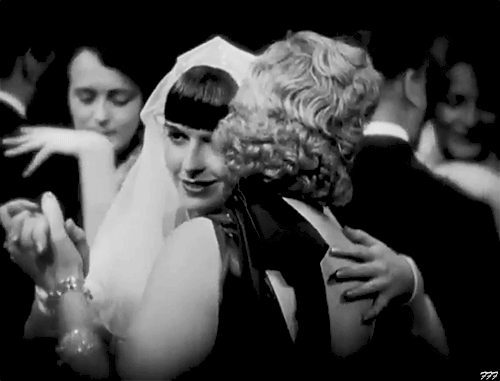
Pandora's Box {Die Buchse Der Pandora} (1929) dir. G.W. Pabst
Based on the Lulu Duology by Frank Wedekind, Pandora's Box is a "Sex Tragedy" that is basically a moral tale. Its a story of degradation essentially if your familer with that fucked up hentai Emergence then you have the concept.
We follow a women named LULU, (not to be confused with lola lola??? from Blue Angel). who is basically a tomie type everyone wants to fuck her and everyone uses her at the same time.
A series of awful things happen and she eventually gets murdered by the literal Jack the Ripper, which if that isn't a metaphor for male sexual entitlement and slut shaming I don't know what is.
These morality tales feel very similar to other films we've seen like Manslaughter! and I don't Want to Be A Man where we have this contrast between this "Wild Child", a decadent hedonistic empowered woman, and her more conservative daddy dom who is like totally not a fascist hes just obsessed with the fall of rome.
Its hard not to see these films as fascist propaganda against the notion of decadence and degenarates and the aspects of queerness within them feel like they are meant to codify those aspects. After all the queers as hedonist fops isn't a hot take by any means.
I still like this film and I don't necessarily think of it as fascist propaganda but its also hard not to see these notions of decadence and hedonism from this lens or at least this conservative moral position.
What I mean is that its hard for me to understand the author as believing these things. Personally I love that all these women are telling men to fuck off and being on some hoe shit.

The Wild Party (1929) dir. Dorothy Arzner
This film is on its surface a story of Clara Bow being a Wild Child albiet one with actually depth and its her lack of responsibilty and immaturity thats criticized not the fact that she likes to drink and drive cars. She has a very hot and cold relationship with a man which is so emblamatic of this era of romance and overall its a lot of straight nonsense which is not the last time your'll here me say that.
What Makes this different is that Arzner is a lesbian

so even though this film is very very very straight on the surface its kinda gay visual, this shit has the lesbian gaze. We Stan
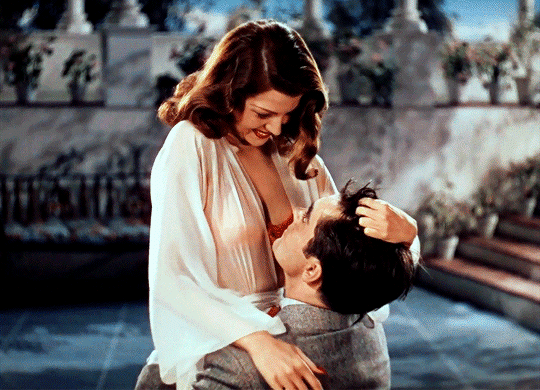
Blood and Sand (1922) dir. Fred Niblo
That Gif is from the 1941 film but its also as heterosexual.
The reason why this is on the list is because on the talk page for WINGS (1927) some guy mentions how this film had a gay kiss in it. The reason why noone mentions it is because 5 minutes in some dude kisses a dead guy on the cheek and then its another 120 minutes of a guy being so straight its boring. Wow i'm a man I can't stop falling dick first into some vagina that doesn't belong to my wife.
You don't even get to be gay for Rudolf Valentino in this because its so boring and blandly shot.
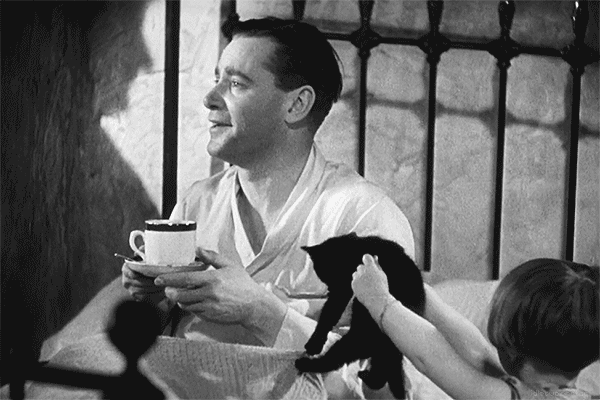
Murder! (1930) dir. Alfred Hitchcock
So this film is not very gay, its definetly cool and I'm kinda glad that I get to watch Hitchcock Films for this project.
Hitchcock was kinda weird when it came to gay shit. He loved to put these queer coded characters and he constantly employed or involved himself with other queer persons, (the writer for Jamacia Inn and The Birds was suposedly Bisexual).
The reason why this is on the list is as a primer for Hitchcocks more explicity queer coded villians, in this film it is a female impersonater who kills because it is about to be revealed that he is "half-caste", (the version I watched had spanish subtitles and the translation was 'Mestiza' so its pretty clear the tone of the term).
Hitchcock has this obsession with it which totally doesn't come off as closeted gay homophobia. So expect more of him to come.

Morocco (1930) dir. Josef Von Sternberg
Yes we finally get to all the famous gay moments in history, lets get into it.
so the scene in question comes in very early into the film where Marlene Dietrich, (who is also Sapphic), dresses up in tails for a Caberet Act. As we all know caberet is super gay and in her butch mode she steals a kiss from a women. The film itself doesn't make a big deal of it and in general its very much lesbian bating for a straight male audience.
On the other hand this film in my mind has a bisexual gaze, its a lot of men and women pining over each other and being sort of gender expansicve??? Like I can't explain what makes a film Bisexual but this is one of them.

(my definition is that everyones hot for no reason and everyones just kinda slutty??? like you just want to kiss every single person openly on their sweet little mouth.)
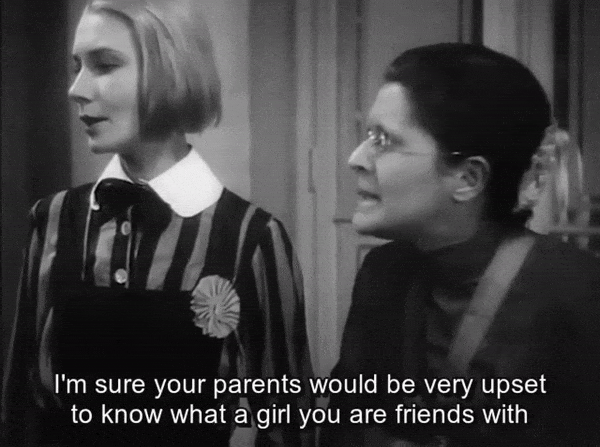
Madchen In Uniform (1931) dir. Carl Froelich, Leontine Sagan
So one of the first films with an all female cast this is also the most explicetly gay film I've ever seen. Like pretty much only Anders die al Aldern comes close and that one literally has a lecture by Magnus Hirschfield.
this one features a scene where this girls teacher/matron kisses her on the lips to say goodnight instead of on the head and wow that gay. Like this film said Mommy this film said praise kink. This film is honestly a kinky lesbians wet dream, (can women have wet dreams we asked 10 men).
this film is just generally queer but strangly enough it also got a lot of criticism for its anti-authotarian messaging. Regardless I found this shit on youtube go watch it.

Various Comedies.
On this list is also Doughboys (1930), Sidewalks of New York (1931), The Play House (1921). There not in the possible bit queer but I watch them as part of getting background on the whole Role Reversal Drag Trope.

Everything Else
Mabel and Fatty's Wash Day (1915) dir Roscoe "Fatty" Arbuckle
Hidden (2020) dir Jafar Panahi
The Kiosk (2020) dir Alexandra Pianelli, which is actually a really lovely documentary which you should find if you can, this is not to be confused with Kiosk(2013) dir Anete Melece, which is a very lovely animated short that you should definetly seen.
Anyway whores I'm gonna talk to you in about a weeks time so stay frosty.
#queer cinema#first gay kiss#movies#diary#pandoras box#the wild party#blood and sand 1921#Murder#morocco#Madchen in Uniform
4 notes
·
View notes
Text
AS HUSBANDS GO
1931

As Husbands Go is a three-act play by Rachel Crothers. It was originally produced by John Golden and staged by the author.
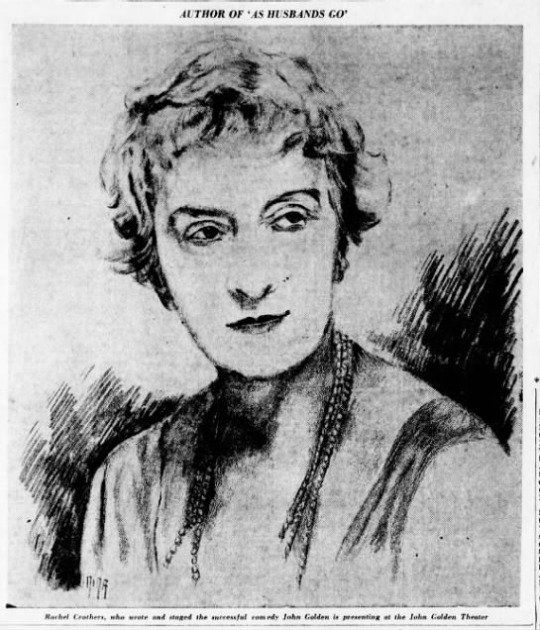
The play takes place at a café in Paris and the living-room in the Lingard House, ten miles from Dubuque, Iowa.
While in Paris, a widow from Iowa and her younger married neighbor, discover alluring gentlemen. The widow is attracted to an elderly boulevardier, while the neighbor is smitten with a handsome (and younger) English author. Instead of souvenirs, the ladies daringly bring the men back home to Iowa.
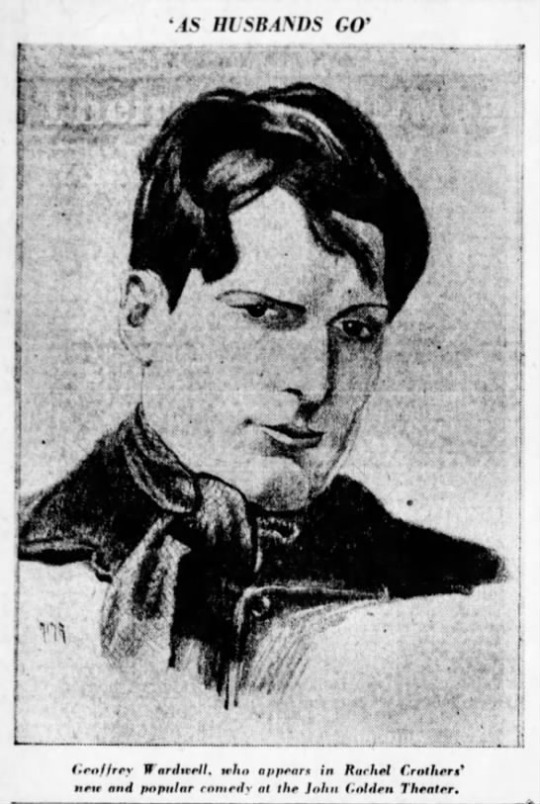
“If all husbands were as gallant as Charles Lingard in Rachel Crothers’ comedy... divorce courts could go out of business; that is, provided all wives were as delightfully tractable as pretty Lucile Lingard.” ~ BROOKLYN LIFE

For the world premiere, Golden chose Brandt’s Boulevard Theatre in Jackson Heights NY. It opened for a week’s stay on February 23, 1931.
The play premiered on Broadway at (fittingly) the John Golden Theatre on March 5, 1931. This was the first of three venues named for the producer. Located on 58th street, it stopped presenting live theatre in 1936 and was demolished in 1985. The third theatre named for Golden is now known as the Bernard Jacobs.

“If a smiling lady should be found dancing in the streets in Fifty-eighth Street, to be specific, with laurel and bay leaves in her hair, that would be Rachel Crothers. For the second time in three years she has taken advantage of John Golden's adventurous generosity and produced a hit in his name when he was no closer to it than Palm Beach, Florida. Ticket brokers, I'm told, are willing to buy all the seats the Golden office will sell for the next several weeks of ‘As Husband Go’, so sure are they that it is to be listed among the hits.”
Mantle is referring to the fact that Golden was seldom in Manhattan. In January 1931 he purchased the play from Havana, and was in Palm Beach when it finally opened.



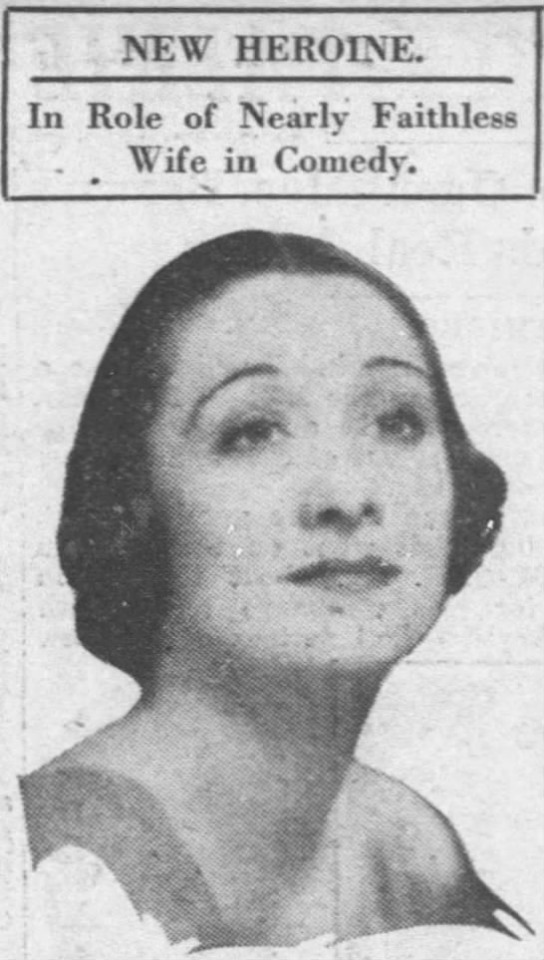
On May 4, 1931 Gloria Holden replaced Lily Cahill as Lucile Lingard. Cahill left the role suddenly for undisclosed reasons. Golden heard Holden on radio and signed her to make her Broadway debut.

The show’s 100th performance (a matinee on May 23rd) coincided with a military air show, so Golden moved the curtain time to 3:15pm to prevent audiences being distracted by the roar of aircraft motors.
At the same time in Los Angeles, producer E.E. Clive had presented a West Coast company of As Husbands Go. Clive would also produce the Broadway revival in 1933.

In late June 1931, Golden invested in some new-fangled technology - air cooling! Perhaps theatres would now be able to operate year-round? Cool!
After Independence Day, the play started to advertise “last weeks” and closed on July 11th. Golden had agreed to the play becoming one of the Theatre Guild’s subscription series. This was a consortium of cities nationwide that would share the same plays. One of those cities was Atlantic City.

Coincidentally, Clive’s California company wrapped up its run on September 12th, just as the Theatre Guild tour was preparing to launch. The production was integral in selling the play to Hollywood.

After a summer break, the play re-opened in Atlantic City at Nixon’s Apollo Theatre on the Boardwalk on September 28, 1931.
A new production, under the guidance of producers O.E. Wee and Jules J. Leventhal in mid-January. Again, Crothers provided direction. Wee and Leventhal were known as “W & L: The Revivers” with six productions in a short period of time - all revivals. Simultaneously, the play had been sold to stock and regional producers, virtually flooding the nation with Husbands!
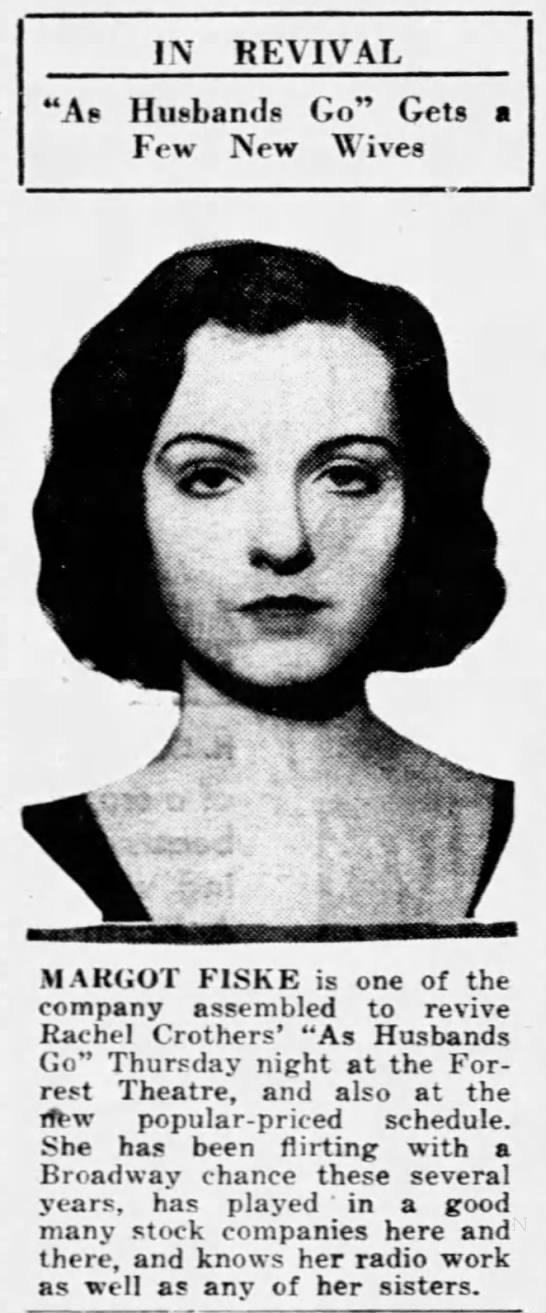
In January 1933, the play returned to Broadway at the Forrest Theatre, today known as the Eugene O’Neill. Remarkably, both the original Broadway production and the Broadway revival ran the same number of performances: 148.
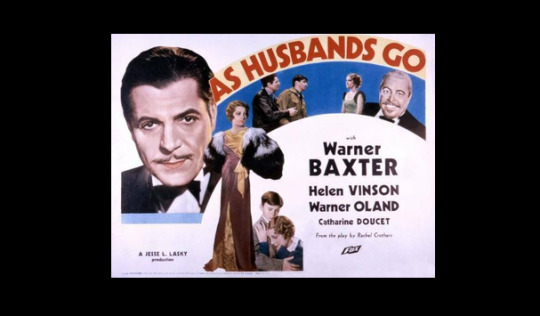
In 1934, a film version was released. The screenplay was written by S.N. Behrman, Sonya Levien, and Fred Niblo Jr. and starred Warner Baxter as the titular Husband.
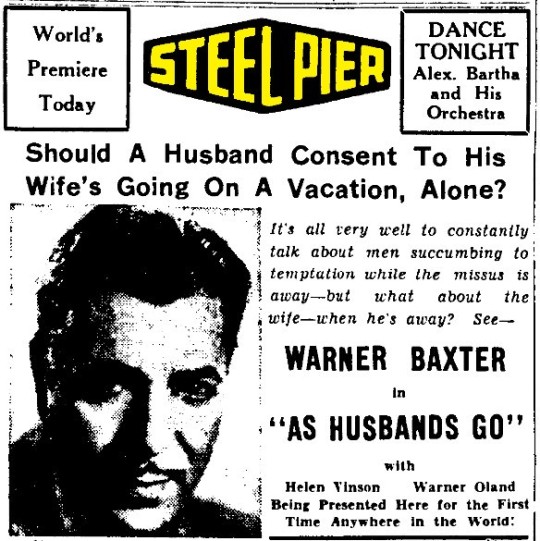
The film had its world premiere at the famous Steel Pier Theatre in Atlantic City on December 3, 1933, nearly two months before its general release in late January 1934.
#As Husbands Go#Rachel Crothers#1931#Broadway#Atlantic City#Broadway Play#Broadway Theatre#Nixon's Apollo Theatre#John Golden
4 notes
·
View notes
Text

"Step Lively!
A Carload of the Funniest Yarns that Ever Crossed the Footlights" by George Niblo (1903)

"It concerned our youngest, who had been getting into trouble again, throwing stones at a neighbor's cat, or doing some such boyish misdemeanor, and his mother expressed her opinion that he was surely a chip of the old block."

"I happened to be in one of those happy Western towns during the heat of a campaign where they serve out cocktails and revolvers to all comers."

"When you manage to run across an original man it pays to cultivate his acquaintance."
4 notes
·
View notes
Photo


Greta Garbo and Conrad Nagel ‘The Mysterious Lady’, 1928
Greta Garbo (1905 - 1990) as the glamorous Russian spy Tania in the romantic drama 'The Mysterious Lady’, directed by Fred Niblo. with her on-screen lover Conrad Nagel (1897 - 1970).
46 notes
·
View notes
Text
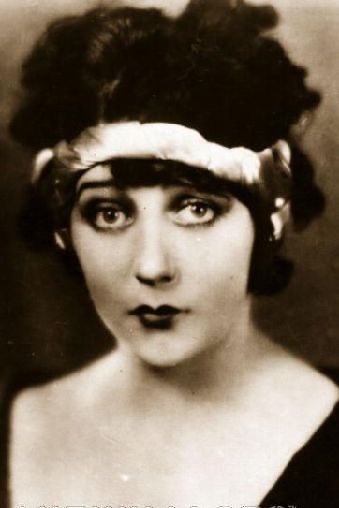
Barbara La Marr (born Reatha Dale Watson; July 28, 1896 – January 30, 1926) was an American film actress and screenwriter who appeared in twenty-seven films during her career between 1920 and 1926. La Marr was also noted by the media for her beauty, dubbed as the "Girl Who Is Too Beautiful," as well as her tumultuous personal life.
Born in Yakima, Washington, La Marr spent her early life in the Pacific Northwest before relocating with her family to California when she was a teenager. After performing in vaudeville and working as a dancer in New York City, she moved to Los Angeles with her second husband and became a screenwriter for Fox Film Corporation, writing several successful films for the company. La Marr was finally "discovered" by Douglas Fairbanks, who gave her a prominent role in The Nut (1921), then cast her as Milady de Winter in his production of The Three Musketeers (1921). After two further career-boosting films with director Rex Ingram (The Prisoner of Zenda and Trifling Women, both with Ramon Novarro), La Marr signed with Arthur H. Sawyer to make several films for various studios, including The Hero (1923), Souls for Sale (1923), and The Shooting of Dan McGrew (1924), the first and last of which she co-wrote.
During her career, La Marr became known as the pre-eminent vamp of the 1920s; she partied and drank heavily, once remarking to the press that she only slept two hours a night. In 1924, La Marr's health began to falter after a series of crash diets for comeback roles further affected her lifestyle, leading to her death from pulmonary tuberculosis and nephritis at age 29. She was posthumously honored on the Hollywood Walk of Fame for her contributions to the film industry.
Barbara La Marr was born in 1896 as Reatha Dale Watson to William and Rosana "Rose" Watson in Yakima, Washington (La Marr later claimed she was born in Richmond, Virginia). Her father was an editor for a newspaper and her mother, a native of Corvallis, Oregon, already had one son, Henry, and a daughter, Violet, from a previous marriage. La Marr's parents had wed some time during 1884, and had a son, William Watson, Jr., born in June 1886, ten years before she was born. Through her mother, La Marr was of German and English descent.
In the 1920s, the elder Watson became a vaudeville comedian under the stage name of Billy Devore. The Watsons lived in various locations in Washington and Oregon during La Marr's formative years. By 1900, she was living with her parents in Portland, Oregon, with her brother William, her half-sister Violet Ross, and Violet's husband Arvel Ross. As a child, La Marr also performed as a dancer in vaudeville, and made her acting debut as Little Eva in a Tacoma stage production of Uncle Tom's Cabin in 1904.
By 1910, La Marr was living in Fresno, California, with her parents. Some time after 1911, the family moved to Los Angeles, and La Marr worked at a department store. La Marr also appeared in burlesque shows. In January 1913, her half-sister, now going by the name of Violet Ake, took her 16-year-old sister on a three-day automobile excursion with a man named C.C. Boxley. They drove up to Santa Barbara, but after a few days, La Marr felt that they were not going to let her return home. Ake and Boxley finally let La Marr return to Los Angeles after they realized that warrants were issued for their arrests, accusing them of kidnapping. This episode was published in several newspapers, and La Marr even testified against her sister, but the case eventually was dropped. La Marr's name appeared frequently in newspaper headlines during the next few years. In November 1914, she came back to California from Arizona and announced that she was the newly widowed wife of a rancher named Jack Lytell and that they were supposedly married in Mexico. She also stated that she loathed the name Reatha and preferred to be called by the childhood nickname "Beth."
After marrying and moving in with her third husband, vaudevillian Ben Deely, La Marr, who at one time had aspirations of being a poet, found employment writing screenplays at Fox Film Corporation using the name Folly Lyell. She wrote numerous scenarios for studio shorts at Fox and United Artists, many of which she based on her life, earning over US$10,000 during her tenure at the studios. She was credited as writer Barbara La Marr Deely on the films The Mother of His Children, The Rose of Nome, Flame of Youth, The Little Grey Mouse, and The Land of Jazz (all released in 1920).
La Marr continued to write short screenplays for the studio and supported herself by dancing in various cities across the country, including New York City, Chicago, New Orleans, and at the 1915 World's Fair in San Francisco. La Marr's dance partners included Rudolph Valentino and Clifton Webb, and her dance routines attracted the attention of publisher William Randolph Hearst, who featured her and a dance partner in a series of articles published in the San Francisco Examiner around 1914.
While working in the writers' building at United Artists, La Marr was approached by Mary Pickford, who reportedly embraced her and said, "My dear, you are too beautiful to be behind a camera. Your vibrant magnetism should be shared by film audiences." La Marr's association with filmmakers led to her returning to Los Angeles and making her film debut in 1920 in Harriet and the Piper. Though a supporting part, the film garnered her attention from audiences. La Marr made the successful transition from writer to actress with her supporting role in The Nut (1921), playing a femme fatale. Later the same year, she was hired by Douglas Fairbanks to play the substantial part of Milady de Winter in The Three Musketeers.
Over the next several years, La Marr acted frequently in films, and became known to the public as "The Girl Who Is Too Beautiful", after Adela Rogers St. Johns, a Hearst newspaper feature writer, saw a judge sending her home during a police beat in Los Angeles because she was "too beautiful and young to be on her own in the big city." This publicity did much to promote her career. Among La Marr's films are The Prisoner of Zenda and Trifling Women, both 1922 releases directed by Rex Ingram. Although her film career flourished, she embraced the fast-paced Hollywood nightlife, remarking in an interview that she slept no more than two hours a night.
In 1923, La Marr appeared in the comedy The Brass Bottle, portraying the role of the Queen, and Poor Men's Wives. She had a supporting part in the Fred Niblo-directed comedy Strangers of the Night, and was noted in a New York Times review for her "capable" performance. She starred in the lead role, with Bert Lytell and Lionel Barrymore, in The Eternal City (1923), which featured a cameo appearance by Italian dictator Benito Mussolini.
In 1924, during the filming of Thy Name Is Woman, production supervisor Irving Thalberg made regular visits to the set to ensure that La Marr's alcoholism was not interfering with the shoot. The same year, La Marr's first starring, above-the-title role came in the drama Sandra, from First National Pictures, which she filmed in New York City in August 1924. La Marr had served as a co-writer on the film, which focused on a woman suffering from a split-personality disorder Upon release, the film received dismally negative reviews.
La Marr's final screenplay, titled My Husband's Wives, was produced by Fox in 1924, arriving in theaters shortly after the release of Sandra, and before the production of what proved to be her final three films: The Heart of a Siren (a mixed reception), The White Monkey (a critical failure), and The Girl from Montmartre (a critical success, albeit posthumously released). While shooting The Girl from Montmartre in early October 1925, La Marr collapsed on set and went into a coma as the studio wrapped production without her with use of a double in long shots.
Although the tally is usually given as five, La Marr officially was married only four times. No documentation exists to prove the existence of her alleged first husband, Jack Lytelle, whom she claimed to have met while visiting friends in Yuma, Arizona in 1914. According to La Marr, Lytelle became enamored with her as he saw her one day riding in an automobile while he was on horseback. The couple allegedly married the day after they met, but Lytelle, it was claimed, died of pneumonia only three weeks into the marriage, leaving only a surname for Mrs. Lytelle to inherit.
La Marr's first official documented marriage on June 2, 1914, was to a Max Lawrence, who later turned out to be a former soldier of fortune named Lawrence Converse. He already was married with children when he married La Marr under a false name, and was arrested for bigamy the following day. Converse died of a blood clot in his brain three days later on June 5.
On October 13, 1916, La Marr married Philip Ainsworth, a noted dancer. Although the son of well-off parents, Ainsworth eventually was incarcerated at San Quentin State Prison for passing bad checks, and the couple divorced in 1917. She married for a fourth time to Ben Deely, also a dancer, in 1918. Deely, who was over twice her age, was an alcoholic and a gambling addict, which led to the couple's separation in April 1921. Before the divorce from Deely was finalized, La Marr married actor Jack Dougherty in May 1923. Despite separating a year later, they remained legally married until her death.
Some years after La Marr's death, she was revealed to have given birth to a son, Marvin Carville La Marr, on July 29, 1922. The name of the boy's father has never been released. During her final illness, La Marr entrusted the care of her son to her close friend, actress ZaSu Pitts, and Pitts' husband, film executive Tom Gallery. After La Marr's death, the child was legally adopted by Pitts and Gallery, and was renamed Don Gallery. Don Gallery died in 2014.
La Marr partied long hours and got very little sleep during the latter part of her career, often pairing this behavior with drinking during especially low points; she once told an interviewer: "I cheat nature. I never sleep more than two hours a day. I have better things to do."[8] In addition to her drinking and lack of sleep, during the last two years of her life La Marr went on several extreme crash diets to lose weight.[8] La Marr was rumored to have at one time ingested a tapeworm head in a pill to help her lose weight.
By late 1925, La Marr's health had deteriorated significantly due to pulmonary tuberculosis. While filming her final feature, The Girl from Montmartre, La Marr collapsed on the set and lapsed into a coma. In mid-December, she was diagnosed with nephritis, an inflammation of the kidneys, as a complication of her already tubercular state. La Marr was bedridden through Christmas, and by late December, she reportedly weighed less than 80 pounds (36 kg).
Some historians and writers have claimed that La Marr was addicted to morphine and heroin, which she had been prescribed after injuring her ankle and which may have contributed to her health problems. In Sherri Snyder's 2017 biography of La Marr, the writer states that these claims were untrue and erroneously reported. A frequently recirculated rumor was that La Marr was arrested for morphine possession in Los Angeles; however, Snyder states that this claim was mistakenly attributed to La Marr, when it had in fact been actress Alma Rubens who had been arrested in January 1931, five years after La Marr's death. Ben Finney, a close friend of La Marr, contested the claims of drug use, stating: "It is inconceivable that during our close friendship I would not have known if she were a junkie," adding, "She did well enough with booze."
On January 30, 1926, La Marr died of complications associated with tuberculosis and nephritis at her parents' home in Altadena, California, at the age of 29. Her friend, film director Paul Bern, was with her when she died. La Marr's son later speculated that Bern may have been his biological father, though this eventually was disproved; Bern died in a mysterious shooting six years later.
La Marr's funeral at the Walter C. Blue Undertaking Chapel in Los Angeles attracted over 3,000 fans, and five women reportedly fainted in the crowd and had to be removed by police to safety. After her removal from the church during the funeral procession, hundreds of fans flooded the chapel hoping to obtain flowers from the decorative arrangements. She was interred in a crypt at Hollywood Cathedral Mausoleum, in the Hollywood Forever Cemetery. For her contribution to the motion picture industry, La Marr has a star on the Hollywood Walk of Fame at 1621 Vine Street.
Producer Louis B. Mayer, a longtime admirer of La Marr, named actress Hedy Lamarr after her. She is also referred to in the popular 1932 Flanagan and Allen song "Underneath the Arches" during a break in which Ches Allen reads the headlines from a 1926 newspaper. Children's author Edward Eager set an episode of his 1954 book Half Magic at a showing of La Marr's Sandra and includes ironic descriptions of the movie.
17 notes
·
View notes
Text

Vilma Banky and Rudolph Valentino in The Eagle (Clarence Brown, 1925)
Cast: Rudolph Valentino, Vilma Banky, Louise Dresser, Albert Conti, James A. Marcus, George Nichols, Carrie Clark Ward. Screenplay: Hanns Kräly, based on a novel by Alexander Pushkin; titles: George Marion Jr. Cinematography: George Barnes. Production design: William Cameron Menzies. Film editing: Hal C. Kern.
It's easy to overlook the absurdities of the story of The Eagle because the filmmakers embrace them, and everyone seems to be having so much fun. Rudolph Valentino is Vladimir Dubrovsky, a dashing (what else?) lieutenant in the Russian Imperial Guard, who catches the eye of Catherine the Great (Louise Dresser) when he rescues a pretty young woman (Vilma Banky) and her aunt (Carrie Clark Ward) from a carriage pulled by a runaway horse. Catherine wants him for herself, of course, but Vladimir is shocked by her advances and flees. Meanwhile, he learns that his father has been victimized by a wicked aristocrat, Kyrilla Troekouroff(James A. Marcus), who has confiscated his lands. When his father dies, Vladimir vows vengeance against Kyrilla, and assumes the identity of the Black Eagle, a Zorro-like figure who wears a mask and rights the wrongs of Kyrilla against the peasantry. (In fact, the Black Eagle wasn't in the Pushkin story on which the movie is based; he was inspired by the success of the 1920 Douglas Fairbanks swashbuckler The Mark of Zorro directed by Fred Niblo.) And wouldn't you know it, Kyrilla's daughter, Mascha, turns out to be the pretty young woman he rescued in the runaway carriage. Disguising himself as a French teacher, he works his way into Kyrilla's household and woos Mascha. Meanwhile, the empress has put a price on Vladimir's head for desertion, so when he manages to win Masca and defeat her father, he still faces a firing squad. This is probably Valentino's most light-hearted performance, and he gets fine support from Banky and especially Dresser as the randy czarina.
9 notes
·
View notes
Text
Interview tag!
rules: answer the questions and tag 20 blogs you are contractually obligated to know better!
I was tagged by @nataly-lanier :D Thanks for the tag!!
- nickname: Patricia, but only pronounced like this
- pronouns: She/her
- star sign: Aquarius
- height: 163 cm
- time currently: 9:15 PM
- when is your birthday: Feb 14th
- favorite bands/groups: frederic, Apocalyptica
- favorite solo artists: Elton John
- song stuck in your head: Nakushita Kotoba - NO REGRET LIFE
- last movie watched: The Disaster Artist
- last show you binged: Navillera
- when you created your blog: Jan 2021
- last thing you googled: sir anthony hopkins niblo cat
- other blogs: I have a few other tumblrs from before I left in 2016, one of them is fuckyeahgible lmao
- why you chose your url: my half french friend told me they call magic wands "baguette magique" in french translations of harry potter but also that baguette is slang for dick so it's like magicdick7 hahahaha (I chose this name for my nsfw twitter before I made a tumblr)
- do you get asks: noooo but pls feel free to ask away
- how many people are you following: 66
- how many followers do you have: 45
- average hours of sleep: A LOT. Like 9-10?
- lucky number: 17
- instruments: piano; i used to play cello and bass too but I don't think I remember how to play XDD
- what I’m currently wearing: maplestory2 pajamas
- dream job: general counsel at nintendo america
- dream trip: I really want to go to London for this two week intensive sewing/fashion design course
- favorite food: fried chicken
- favorite song: there's too many to choose!
- top three fictional universes you’d like to live in: Pokémon, story of seasons, animal crossing
TAGGING: @queensbrother, @daydreamslug, @rumseyrum - if you want? :)
3 notes
·
View notes
Photo


Angiolina Bosio (22 August 1830 - 12 April 1859) was an Italian operatic soprano who had a major international career from 1846 until her premature death in 1859 at the age of 29. She sang at the most important opera houses in Boston, Havana, London, Madrid, Moscow, New York, Paris, Philadelphia, Saint Petersburg, and Verona. She was particularly admired for her performances in operas by Giuseppe Verdi.Her voice, although of limited volume, was exceptionally extended and flexible, capable of a large and touching phrasing. Angiolina Bosio was compared by contemporary critics to other famous sopranos, such as Maria Malibran and Henriette Sontag. From 1840-1847 she studied singing in Milan with Venceslao Cattaneo. She made her professional opera debut in that city in 1846 at the Teatro Real del Circo as Lucrezia Contarini in Giuseppe Verdi's opera I due Foscari. She returned to that theatre in 1848 to portray the role of Amazily in the world premiere of Ignacio Ovejero's Fernand Cortez. In 1847 she made successful appearances at the Teatro Carcano in Milan, the Teatro Filarmonico in Verona, the Royal Danish Theatre in Copenhagen, and the Teatro Real in Madrid. In 1848 Bosio made her debut at the Paris Opera as Lucrezia Contarini to only moderate success. Following this performance, she lately undertook a North American trip which lasted from 1848-1851. She made appearances in theatres in New York City, Boston, Philadelphia, Baltimore, and Havana; drawing acclaim from audiences and critics in all of those cities. She notably portrayed the role of Lady Macbeth in the United States premiere of Verdi's Macbeth at Niblo's Garden in New York in 1850. In 1851 Bosio returned to Europe and was married that year to a Greek man with the surname Xindavelonis. In 1852 she made her debut at the Covent Garden in London as Adina in Gaetano Donizetti's L'elisir d'amore. She had two major triumphs at that theatre later that year when she performed the roles of Elvira in Vincenzo Bellini's I puritani and the title role in Donizetti's Lucia di Lammermoor; notably replacing Giulia Grisi in the latter production. In 1852-1853 she was heard much more successfully at the Paris Opera in a variety of parts, including the title role in the French premiere of Luisa Miller. In the Summer of 1853 she returned to Covent Garden where she was much admired as the title heroines in Louis Spohr's Jessonda and Gioachino Rossini's Matilde di Shabran. On 14 May 1853 she portrayed Gilda in the English premiere of Verdi's Rigoletto to great success.[2] In 1853 Bosio accepted an invitation to join the roster of singers at the Bolshoi Kamenny Theatre in Saint Petersburg, Russia where she was given the title "Première Cantatrice" and was the highest paid singer at the theatre. She sang opposite tenor Enrico Tamberlik frequently at this opera house and performed numerous times in operas and concerts attended by Alexander II of Russia. In 1855 she left Russia to join the Théâtre-Italien in Paris where she was heard in operas by Verdi and Donizetti, and as Matilde di Shabran and Zarele in Giovanni Pacini's Gli arabi nelle Gallie. In 1856 she returned to Covent Garden as Violetta in Verdi's La traviata in a performance that was interrupted numerous times by thunderous applause from an enthusiastic audience She was also heard there as Catherine in the English premiere of Giacomo Meyerbeer's L'étoile du nord. In 1858 she performed again in Russia, first at the Bolshoi Theatre in Moscow and then again at the Bolshoi Kamenny Theatre. She returned to Moscow for another performance and then was traveling by train back to St. Petersburg when she caught a bad cold. The disease affected her badly and her health rapidly declined. She died in 1859 at the age of 29 in Saint Petersburg. Her funeral drew a large crowd in St. Petersburg and a monument was erected in her memory near the cathedral at the Alexander Nevsky Monastery where she is buried She is mentioned in Nikolay Chernyshevsky's novel What Is to Be Done? and in poems by Nikolay Nekrasov and Osip Mandelstam.
2 notes
·
View notes
Text
Watch SAS Red Notice online English 2021
SAS Red Notice 2021 full - https://sas-red-notice-eng.blogspot.com/
Rating: R (language throughout | strong / bloody violence) Genre: Action Original language: English (United Kingdom) Directed by Magnus Martens Producer: Laurence Malkin, Allan Niblo, Joe Simpson Author: Laurence Malkin Release date (streaming): March 16, 2021 Duration: 2h 3m Production Co: Altitude Films A SAS agent finds his romantic short vacation in Paris cut short when a high-quality mercenary target kidnaps a train in the Channel Tunnel.
The market for hard-hitting British action thrillers was rather cornered by James Bond. It's rare for the UK to have really solid action spectacle without Ian Flemings 007 joking his way through the middle and making it feminine. With that in mind, director Magnus Martens' SAS: Red Notice feels like a rare and rather welcome animal. It's the kind of film Hollywood can easily produce - with everyone from Jason Statham and Vin Diesel to Nicolas Cage and Liam Neeson - but this film has a decidedly British feel to it.
Outlander star Sam Heughan - often suggested as the main competitor for 007 in the future - leads the film as Special Forces agent Tom Buckingham. Interestingly, he's a spoiled, classy boy who grew up in a mansion, which makes him far from being a Bruce Willis-style everyone in a bloody vest. After participating in a raid on a group of mercenaries, he takes a much-needed break by kidnapping his doctor partner Sophie (Hannah John-Kamen) to Paris for a romantic marriage proposal. Unfortunately, he got really bad luck when his cross-channel train was kidnapped in the tunnel by the psychopathic mercenary leader Grace (Ruby Rose).
It's a pretty standard action setup, but Martens makes the most of it. The script by Laurence Malkin and Chad Thumann - adapted from the novel by ex-soldier Andy McNab - is elegantly drawn and combines exciting set pieces and crunching action with solid emotional beats. After more than two hours, there is no doubt that the film is a little limp and overly long, but it is never anything other than outstanding to watch, which makes up for a multitude of sins. It helps that Heughan and Rose form a dynamite pair of leads. Heughan is just as charismatic as he has dedicated himself to the action sequences. He wears scenes of polite bravery and bruising with the kind of serenity that suggests he would actually make a terrific 007. It's not easy to sympathize with such an obvious classy boy, but Heughan manages to do it in his scenes with John-Kamen and a brief bond he shares with a young passenger on the train. He's also good at comedy, including a scene with perhaps the most surprising thing ever seen on the floor of a train toilet. Or maybe not. Anyone who's used the loo on a long distance Pendolino is likely to have some stories.
Rose is a perfect sparring partner for Heughan, both physically and verbally. An argument between the two in act three is perfectly choreographed and encompasses the grubby realism of facial claws and swinging limbs rather than the hyper-stylized punches and shots of other action films. Red Notice is a film ready to go its own way in terms of visual spectacle. A downright fallible hero meets his match in a shrewd, ruthless opponent who will never stay down and give up.
However, when it moves its focus away from Heughan and Rose, the film more than stuck a little. Most importantly, there is an overarching political conspiracy involving Ray Panthakis Prime Minister and Andy Serkis as a corrupt military guy too complex and labyrinthine for his own good. These extended sojourns in back room intrigues are much less exciting than the events on the train and only serve to furnish the film with furniture it doesn't need. Its bite is much stronger than its bark, but it ends up barking too long. Fortunately, it won't be long before the movie is back with Heughan, Rose, and the heavy-hitting action core at the heart of this film. Given the rather variable quality of Sky Cinema's original excursions, this is a pleasant surprise. Heughan, Barbara Broccoli, and the Bond team could certainly make it a lot worse.
SAS: Red Notice is the type of action film you'd want to dig into its narrative and characters. There are tons of gunshots, bangs, bangs - don't worry - but there is also a lot of emotional engagement between the players and a story that has a lot more gray areas than just "good versus bad". The film struggles in a few areas, but its intent gives it at least a few points. You can see what it's trying to do and you want it to pin it down. Will it get there or not? Well let's sum it up.
In the beginning, we believe our narrative will follow Grace Lewis (Ruby Rose) and her family - "lovingly" known as The Black Swans. We're not going to spoil any specific details, but some actions in about ten minutes make it clear that the Lewis family are not the heroes of this story. No harm, no foul there. We start with antagonists all the time. The problem is that the story frames them as protagonists before things go sideways. The water just gets muddy as the story progresses. Once we have witnessed some unfortunate deeds committed by the swans in Georgia (not our Georgia, the other) we meet Tom Buckingham III (Sam Heughan). Now it's pretty clear that Tom is our dashing hero. He has everything the stereotypical espionage protagonist has to offer, right down to devilish charm. He will become his lover, Dr. Sophie Hart (Hannah John-Kamen), despite the ocean of differences between them, make a suggestion. But first he has to defeat those annoying swans. It's a quick entry and exit, despite the profile of those they are supposed to capture. Without a few sacrifices (one of which is very important to Grace), things go smoothly and our ignorant hero returns to Sophie's hospital.
He really loves her - a refreshing aspect of the movie - but she struggles with the fact that he doesn't seem to find any human response to anything in the world but her. Blinded to her concern and convinced of his bragging rights, Tom takes Sophie to France by train.
Of course, their move happens to be the same one that Grace and the rest of the Swans attempt to kidnap for reasons we won't discuss in a spoiler-free review. What I will confirm is that they really had no intention of meeting Tom or ruining his proposal. Talk about a crazy coincidence.
SAS Red Notice free movies online SAS Red Notice free movie
SAS Red Notice full
#SAS Red Notice movies#SAS Red Notice watch for free#SAS Red Notice online free#SAS Red Notice watch free online
1 note
·
View note
Text
How THE BARBARIAN (’33) helped Ramon Novarro Realize His Dream by Raquel Stecher
The year 1933 found actor Ramon Novarro at a crossroads in his life. After a successful career in silent movies and a fluid transition into talkies, he was offered a lucrative contract with MGM. It would be his last movie contract and he knew his days as a leading man were coming to a close. Acting wasn’t Novarro’s true passion. Instead, he dreamed of becoming an opera singer, a vocation highly regarded in his native country of Mexico. By the mid-1930s, he was essentially keeping up the movie gig to help finance this dream. According to Novarro biographer Allan R. Ellenberger, “Ramon was entertaining the idea of leaving films and devoting himself entirely to his music… his love of music was still not enough incentive for him to quit. He wanted to secure the financial independence of his family before abandoning films for good.” Novarro agreed to star in MGM’s THE BARBARIAN (’33) with plans to leave immediately after production for a European concert tour.
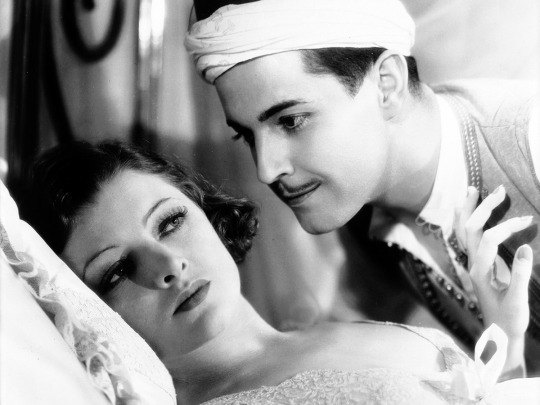
Novarro became an overnight sensation in Hollywood with Rex Ingram’s THE PRISONER OF ZENDA (‘22) and secured his legacy with the lead role in director Fred Niblo’s biblical epic BEN-HUR: A TALE OF THE CHRIST (’25). He was one of the celebrated “Latin Lovers”, a trio that included Rudolph Valentino and Antonio Moreno. Novarro wasn’t on the same level as Valentino or matinee idol John Gilbert, but he had on-screen charisma, box office appeal and an exotic yet accessible persona that garnered him legions of fans. The Mexican star rarely played actual Latino characters. Instead, Novarro became a veritable chameleon playing everything from French, German, Spanish, British, Italian, Austrian, Russian, Israeli to Persian, Chinese, Indian and Native American.
THE BARBARIAN saw Novarro reprising his previous role in Rex Ingram’s THE ARAB (’24). The story was based on Edgar Selwyn’s play The Arab which enjoyed a successful run on Broadway in 1911 and was later adapted to film by Cecil B. DeMille for Paramount Pictures in 1915. Riding the coattails of the phenomenal success of Valentino’s THE SHEIK (‘21), MGM again Selwyn’s story with Novarro as their star. However, by 1933 the story was already considered old-fashioned. Writers Frances Goodrich and Albert Hackett took a stab at adapting Selwyn’s play but gave up with Hackett proclaiming, “It was all so false, all hooey.” The script was eventually handed over to writers Anita Loos and Elmer Harris who took on the task of bringing the story up to date and adding the sensational touches that Depression era audiences craved.
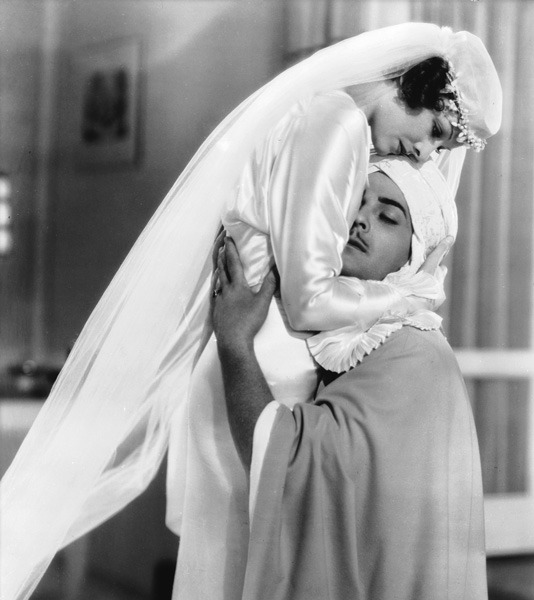
In THE ARAB, Novarro plays Jamil, the disgraced son of a Sheik turned dragoman (tour guide) who falls in love with the daughter of a Christian missionary. Novarro’s leading lady, Alice Terry, was white and the threat of miscegenation, a big no-no in early Hollywood, was thwarted by allowing the audience to imagine a future reunion essentially pausing the romance but avoiding a sad ending. The writers took a few elements of Selwyn’s story but essentially fashioned a completely new tale of an Egyptian dragoman who seduces white women out of their precious jewels. MGM assigned their new leading lady Myrna Loy in the role of Diana, Novarro’s love interest. The writers fixed the miscegenation issue by having Novarro’s leading lady Diana reveal herself as half Egyptian.
THE BARBARIAN did well at the box office and according to film historian Lawrence J. Quirk, it was “well received and slightly arrested [Novarro’s] downward slide.” In the film, Novarro showcased his singing skills with Nacio Herb Brown and Arthur Freed’s original song “Love Songs on the Nile,” which Novarro sung in both Arab and English.
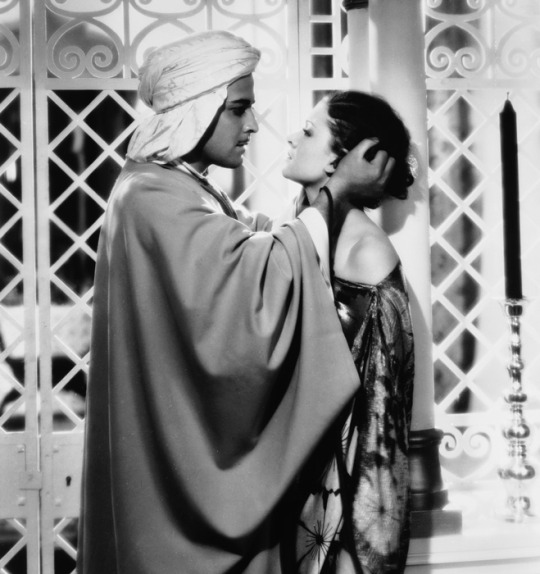
Novarro and his co-star Myrna Loy became fast friends. Loy saw him off at the train station and a photograph of the two parting ways made headlines. To give the film a boost, the MGM publicity team used this to spread a rumor about a romance between the two stars. In her memoir Being and Becoming, Myrna Loy said, "it was preposterous. Ramon wasn't even interested in the ladies and I was seeing Arthur [Hornblow, Jr.] exclusively, so the publicity department had chosen a most unlikely pair."
THE BARBARIAN was scandalous enough to be banned from a re-release in 1934 once the Production Code was fully enforced. It’s best known for a tantalizing scene depicting Loy nude in a bath adorned with flowers (in reality she wore a nude body stocking). As for Novarro, he left Hollywood behind, not for good, but for 20 glorious weeks as he got to live out his dream of being a professional singer. He made 34 stops on his concert tour and his devoted fans flocked to see him perform.
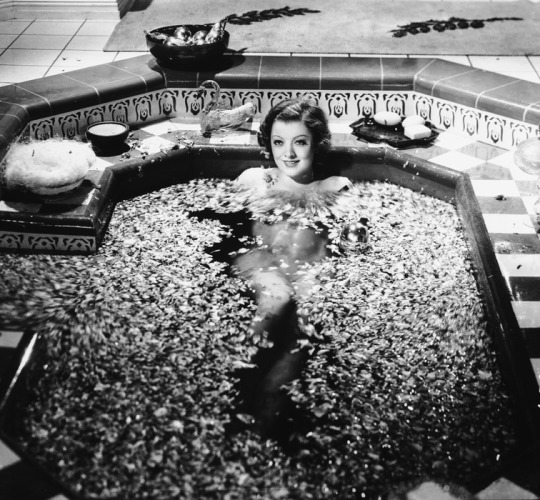
63 notes
·
View notes
Photo

William Merritt Chase - Carmencita, 1890.
Carmencita, the dancer known as the “Pearl of Seville,” was born in 1868 in Almería, on the southeastern coast of Spain, and became famous in her home country and in France during the 1880s. After she made her New York debut in 1889 at Niblo’s Garden, she was besieged with requests for private performances. John Singer Sargent arranged for her to perform in Chase’s studio on the evening of April 1, 1890. Afterwards, Chase painted this lively portrait of the dancer, in which he suggested the audience’s enthusiasm by including the gold bracelet and flowers they had tossed at her feet. Sargent’s own portrait of Carmencita (also 1890) is in the Musée d’Orsay, Paris.
Credit: The Metropolitan Museum of Art
Art Through Time
#william merritt chase#19th century#nineteenth century#american#oil on canvas#painting#oil painting#american art#american impressionism#canvas#dance#music#new york#north america#portrait#united states#spain#the met#The Metropolitan Museum of Art
2 notes
·
View notes
Photo

Greta Garbo and Conrad Nagel in The Mysterious Lady (1928) by Truus, Bob & Jan too! German postcard by Ross Verlag, no. 3787/4, 1928-1929. Photo: Metro-Goldwyn-Mayer. Publicity still for The Mysterious Lady (Fred Niblo, 1928). Collection: Joanna. Swedish Greta Garbo (1905-1990) is often regarded as one of the greatest and most glamorous movie stars ever produced by the Hollywood studio system. She was part of the Golden Age of the silent film of the 1920s and was one of the few actors who made a glorious transition to the talkies. She started her career in the European cinema and would always stay more popular in Europe than in the USA. For more postcards, a bio and clips check out our blog European Film Star Postcards or follow us at Tumblr or Pinterest. https://flic.kr/p/rnktQp
2 notes
·
View notes